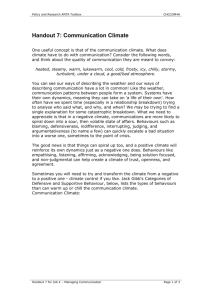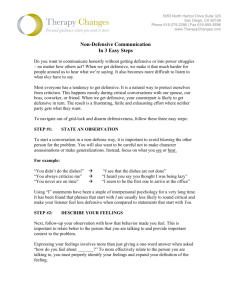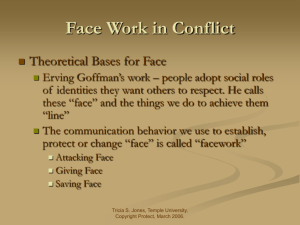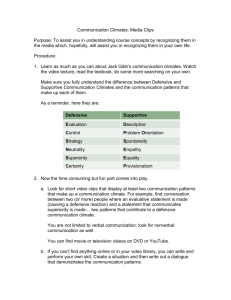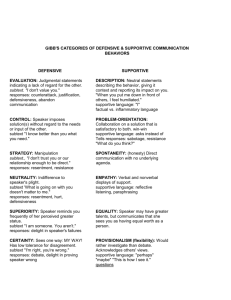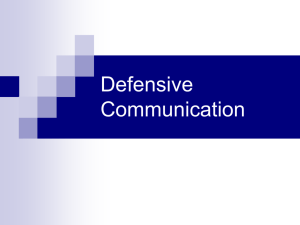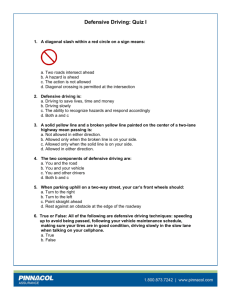Defensive Supportive
advertisement
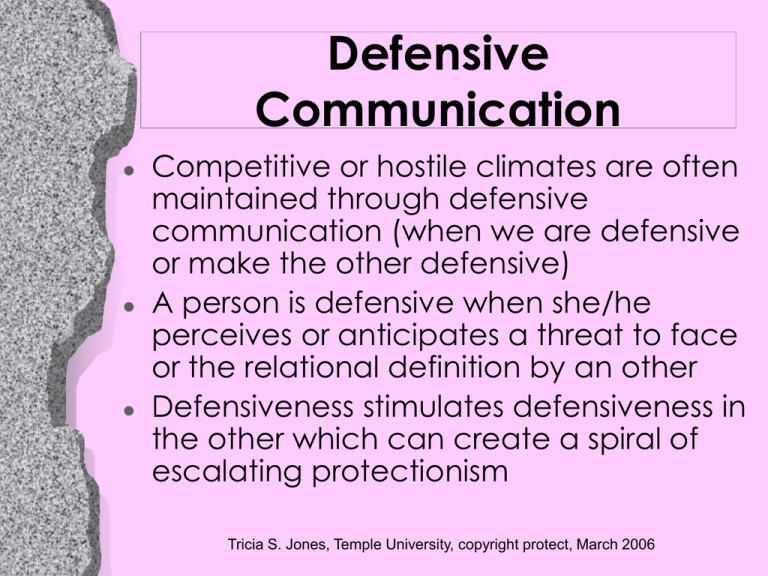
Defensive Communication Competitive or hostile climates are often maintained through defensive communication (when we are defensive or make the other defensive) A person is defensive when she/he perceives or anticipates a threat to face or the relational definition by an other Defensiveness stimulates defensiveness in the other which can create a spiral of escalating protectionism Tricia S. Jones, Temple University, copyright protect, March 2006 Defensive vs. Supportive An alternative to Defensive communication is Supportive communication. Gibb outlined 6 ways one can communicate either defensively or supportively: Defensive Supportive 1. Evaluation vs. Description 2. Control vs. Problem Orientation 3. Strategy vs. Spontaneity 4. Neutrality vs. Empathy 5. Superiority vs. Equality 6. Certainty vs. Provisionalism Tricia S. Jones, Temple University, copyright protect, March 2006 Defensive vs. Supportive Evaluation vs. Description Evaluative language judges, quantifies, or accuses – “YOU” language Descriptive language focuses on the speaker’s perceptions – “I” language Tricia S. Jones, Temple University, copyright protect, March 2006 Defensive vs. Supportive Control vs. Problem Orientation Control messages impose one person’s views on an other without concern or interest in what the other thinks or feels Problem orientation signals respect and the desire to make a decision or find an agreeable solution Tricia S. Jones, Temple University, copyright protect, March 2006 Defensive vs. Supportive Strategy vs. Spontaneity Strategic communication refers to a speaker with an agenda or ulterior motive Spontaneity, in the sense of honest and forthright communication, refers to a speaker who shares thoughts and feelings openly Tricia S. Jones, Temple University, copyright protect, March 2006 Defensive vs. Supportive Neutrality vs. Empathy Neutral communication does NOT offer a diplomatic point of view on an issue –it conveys indifference to the other Empathy involves understanding and appreciating the other’s feelings Tricia S. Jones, Temple University, copyright protect, March 2006 Defensive vs. Supportive Superiority vs. Equality Superior communication sends the message that all others are inferior or inadequate in some way, therefore, the speaker has no interest in what they might say Equality in communication sends the message that the other is valued and worthy as a human being Tricia S. Jones, Temple University, copyright protect, March 2006 Defensive vs. Supportive Certainty vs. Provisionalism Certainty: People who believe they are right and communicate this clearly incite defensiveness in others because they come across as narrow-minded and unwilling to listen to another point of view Provisional communication involves acknowledging other points of view – “I may not agree, but you’re entitled to your own opinion.” Tricia S. Jones, Temple University, copyright protect, March 2006
